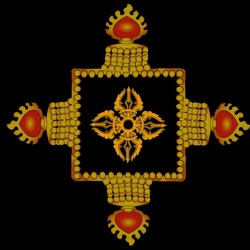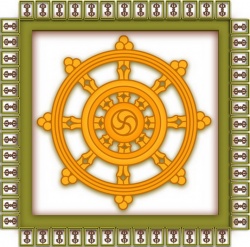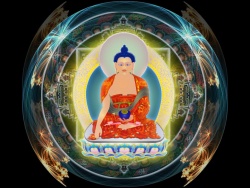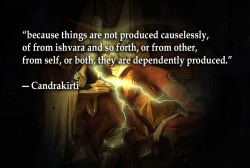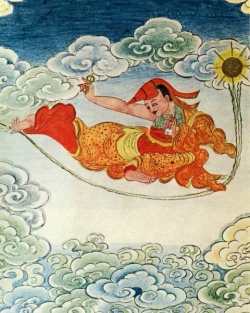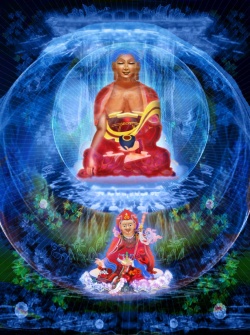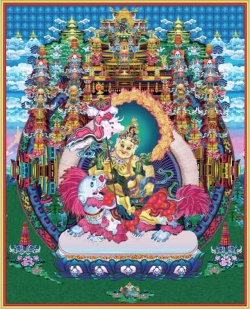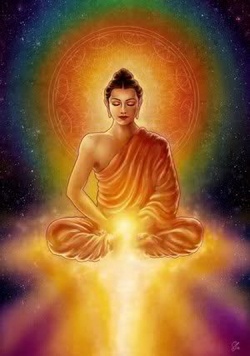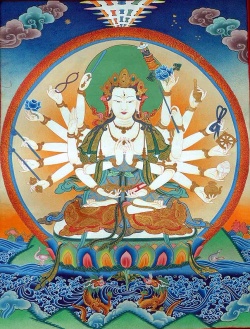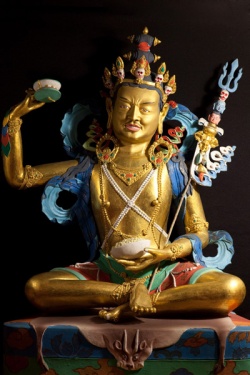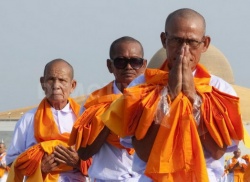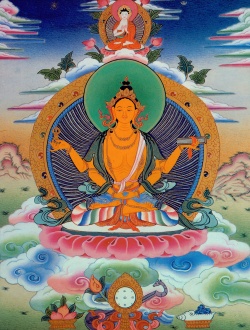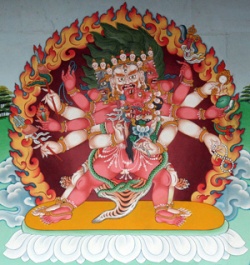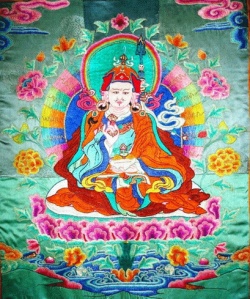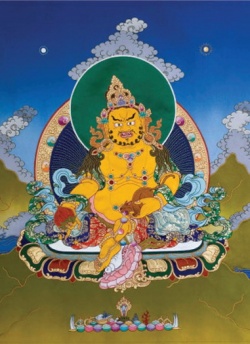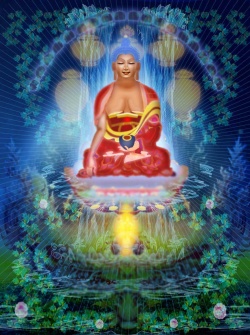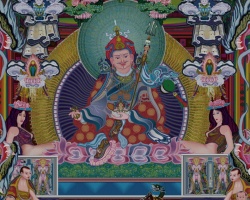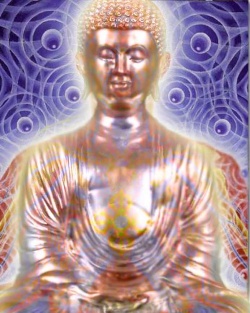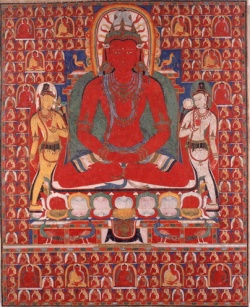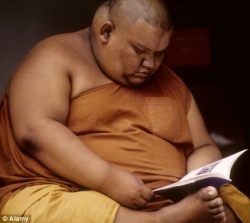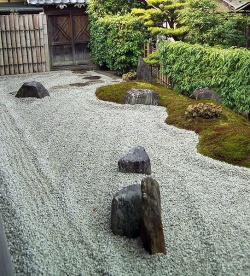Way of practice leading to Nibbāna
“namo tassabhagavato arahato sammasambudhassa”
nibbānagaminipatipada
way of practice leading to Nibbāna
BY PA-AUK TAWYA SAYADAW
TRANSLATED BY
U MYINT SWE (M.A London)
nibbānagaminipatipada (PA-AUK TAWYA SAYADAW)
2
Mental Concomitants common to all types of Consciousness
Consciousness
(1) Phassa
1 – Its characteristic is the contact (meeting) with the object.
2 – Its function is to strike the object and consciousness, or to join consciousness to the object (or to join the object and consciousness together), or to create the meeting of the base (i.e. sensitivity) and object.
3 – (a) Its manifestation is the state that arises due to the meeting of three things-bases (sensitivity), object and consciousness,
(b) Or the state that makes arising of the result, sensation.
4 – Its immediate cause is the object that appears (on the sensitivity).
(i) Characteristic – As explained in the section on consciousness-aggregate, there are three ways of explaining analytically the real (original) meaning of ultimate realities by using the nominative, instrumentive and impersonal; of them the analytical explanation using the nominative and instrumentive is not correct, but the only explanation having (meaning) the impersonal (abstract) sense is said to be correct, and so it is said that the characteristic of Phassa is “contact”. Among these three methods of explaining the ultimate realities,
(1). in the first case of explanation by using the nominative case, it is to be understood that there is not other agent except Phassa itself that makes contact with the object, for it is Phassa itself, but not Attā (soul) that makes contact with the object. This is not a true statement but a figurative speech used in order to reject the soul-theory that Attā or soul makes contact with the object.
2. It is only due to the Phassa that the associated things come into with contact the object. Coming into contact (meeting) with the object is achieved (accomplished) by Phassa, but not by Attā or soul. This also is not a true statement but a figurative speech used in order to reject the soul-theory that contact (meeting) with the objects achieved by Attā soul, but actually Phassa has not power to achieve (accomplish) the contact with the object.
It I a true statement that Phassa has the characteristic of coming into contact (meeting) with the object, but Phassa’s contact with the object and consciousness is not like the touching of two fingers on a material things, and so, it is just a state that arises in the manner of meeting (contact). In the worldly (common) sense the two things touching or being attached to each other exist side by side. However Phassa’s contact with consciousness and the object is not like touching of the two wooden sticks existing side by side. Just as, when the visible object strikes the eyesensitivity, the meeting of the eye-sensitivity and the visible object, is a mere elemental contact not being attached to each other, even so Phassa contacts with consciousness and object, without being attached to them.
Sanghttarasa – This term express the twofold Rasa or function, namely – kiccarasa and Sampattirasa of them.
1. Kiccarasa – Just as the visible object elementally strikes the eye-sensitivity, or the audible object the ear-sensitivity, without being attached to each other, even so Phassa , contact also Translated by U Myint Swe (M.A London)
arises as if elementally striking its associated consciousness and object without being attached to them. This is kiccarasa. It is due to the Phassa’s elementally striking that there is meeting of consciousness and object, which are joined (connected) by Phassa. If Phassa strikes only the object but not consciousness, or only consciousness but not the object, there cannot be the meeting of consciousness and object. Therefore sangattana or striking is only a phenomenon by which there is the meeting of consciousness and object; in other words, the meeting of consciousness and the object is due to Phassa. This (their) meeting is indeed called striking”.
This means that striking is not a separate thing from the (their) meeting. Phassa is just a condition which causes the mind’s elemental striking at the object. 2. The striking of one palm at another (one) is just the striking of material elements which have the stronger force (power) of air-element. In clapping, the two palms strike each other. The two palms also are just a group of material elements which are ultimate realities; each of the two palms has five kinds of material groups, or (in other words) the forty four kinds of mater. (If vitality nonad is included, the number of material qualities will be more than forty four material qualities. (See the section on meditation).
The force (power) of the mind-born air-element is the greatest of material qualities existing in these two palms. The mutual striking material groups, existing in the page – 294 two palms, which have more powerful force of mind-born air element is in other words (metaphorically) called clapping, or touching (striking) of two palms. Exactly in the same way, the mind’s attention to the object and the being (becoming) of the object to be known is called the touching (striking) of mind and object. Phassa, a special phenomenon, depending on mind (consciousness), which arises in the mode (manner) of striking, is metaphorically, called by the commentator, sangattana the mind’s striking at (on) the object. (See Mula TT 1-86; Anu TT 1-93)
The Phassa’s elemental striking (at the object) is in some cases as evident as the physical contact. Regarding the mode of Phassa's striking is explained by the sub-commentary by three similes, viz.
1. There arises the trembling in a frightened person who is looking at (watching) someone on the top of the tree, who is about to fall down.
2. There arises the driveling (slavering) in a person who sees someone eating sour things (fruits) such as lime, mango fruits etc.
3. There arises the trembling of the body of a virtuous and compassionate person when he sees someone beaten and tortured.
In such cases, Phassa's contact with the object is very evident. (see AnuTT 1-93) Sampatti-rasa: - As Phassa arises due to the striking (meeting) of its base (heart) and object know that it (Phassa) has also a full (complete) function as its Sampatti-rasa due to the striking of its base and object, which is called Sanghattana-rasa. Here “Sampatti” means not perfection (completeness) but a natural process in full, as stated by Anutikā, a sub-commentary.
Five-door and Mind-door Processes
It is explained in the great commentary. Every Phassa arising in the four spheres (realms), namely, Kāma, Rūpa, Arūpa and Lokuttara, has truly a characteristic of touching in the manner of striking (meeting with) the object. “Sanghattana-rasa” (function of striking), is said to be obtained in Phassa arising only in the Five-door process, but it can be (also) obtained in Phassa arising in the Mind-door process, in the sense of Function, though not in the sense of “Sampatti”.
True - Phassa arising in the Five-doors has the characteristic of touching and also the function of striking (Sanghattana-rasa), but Phassa arising at the Mind-door has only the characteristic of touching, but not the function of striking. The above statement is again explained in the great commentary, quoting the passage of the “Milinda-pañha”:-
"Great King!, for example, when the two goats strike each other with their horns, note one goat as the eye-sensitivity and the other one as the visible object, and the meeting of those two goats as Phassa. Thus Phassa has the characteristic of touching (contact) in the manner of meeting with the object, and also “Sampatti-rasa”, that is, function of being complete (perfect) due to the meeting of the base and the object. (It is the same in the similes, the striking of two cymbals, or of two palms and so on.)
Or, in the phrase, “Cakkhunā rūpam disvā”, stated in the canonical texts, Cakkhu (eye) is taken as eye-consciousness, not as eye-base or eye-sensitivity, and so this phrase means that the eye-consciousness sees the visible object, being taken as a figurative speech, meaning that eye consciousness is used in the name of eye, “Cakkhu”. In the above mentioned Milindapañha also, eye-consciousness is similarly used in the name (term) of (just) Cakkhu or eye, and so on.
Then, in the “Milinda-pañha” also, Phassa is said to have “Sanghatta-rasa” in the sense of function, as it strikes both the mind (consciousness) and the object. (Abhi-A -1- pp. 151-2)
It is decided in the above said commentary that Phassa arising at the mind-door can have 'Sanghattana-rasa' in the sense of function, though not having it (Sanghattana-rasa) in the sense of 'Sampatti' (completeness or perfection). This means that Phassa arising at the mind-door has kicca-rasa, which is the arising the manner of connecting the consciousness with the object, and in the manner of striking the consciousness and the object. Paccupatthāna - Manifestation -
1. Upatthākāra-Paccupatthāna -As the Buddha said in the canonical texts, Phassa is manifest to the knowledge of a meditator who contemplates it (Phassa) as a phenomenon arising due to the conjunction of three things-bases (sensitivity), object and consciousness. This is Upatthākāra-Paccupatthāna.
Phassa is manifest to the knowledge of a mediator who contemplates it (Phassa) in the mode of arising due to the conjunction of three things - base (sensitivity), object and consciousness, as the Buddha said to his disciples by way of Phassa's condition which is (said to be) the conjunction of three things - base (sensitivity), object and consciousness. True, in the canonical texts, it is said that Phassa arises due to the conjunction of those three things, and so the conjunction of those three things is said to be Phassa's condition. --- Thus, as the Buddha said that Phassa arises due to the conjunction of three things - base (sensitivity), object and consciousness, and is manifest to the knowledge of a meditator in the mode of conjunction of three things, this manifestation is called 'Sannipāta- Paccupatthāna', meaning that Phassa is manifest to the knowledge of the meditator as a Translated by U Myint Swe (M.A London)
5
phenomenon that arises due to the conjunction of three things - base (sensitivity), object and consciousness.
2. Phala-Paccupatthāna - In accordance with the formula of Paticca- samuppāda, Phassa brings about produces the result of feeling (vedanā). This is ' Phala-Paccupatthāna'. In the case of Page 297 Phassa's bringing about feeling, the following simile is given in the commentary: -
Look at live coal, (stick) lac, heat (vapour) - the live coal is an external thing cause to soften the hard lac. When the lac is placed (roasted) upon the live coal, there arises the heat element (vapour) in the lac. Though the heat element (vapour) arises due to the live coal, it just softens the lac on which it depends, but not the coal.
In the same way- 1. the external cause - base (sensitivity) and object,
2. consciousness, and
3. Phassa (contact), of these three things (phenomena) Phassa that arises due to any cause of base (sensitivity) and object which are evident, cannot be said to cause Vedanā (sensation) to arise, but actually the only Phassa that arises depending on consciousness causes Vedanā to arise in consciousness. Although the base (sensitivity) and object are the cause of Phassa, this Phassa does not cause Vedanā either in the base (sensitivity) or in the object. Here, 1. the base (sensitivity) and object are like the live coal, 2. the consciousness is like the lac,
3. Phassa is like the heat element (Vapour), and
4. Vedanā (feeling) that arises due to Phassa is like softness of lac due to the heat element (vapour).
In the case that Phassa brings about produces the result of Vedanā, it is said that it causes Vedanā only in consciousness; and it shows (means) that Phassa is a phenomenon or a mental factor that depends on consciousness and (that) can strike just Vedanā, unmixed with the base (sensitivity) and object. But its depending on the corresponding material base (sensitivity) is not rejected, but Phassa associates only with consciousness, not with material base (sensitivity) on which it depends.
Padatthadāna = proximate cause: - Phassa's proximate cause is the object that appears without obstruction: due to the proper attention or adverting consciousness and eye-sensitivity or faculty and so on, which create the appearance of Phassa. (Abhi-A- 1-152) Page 298
In the statement that Phassa has as its proximate cause, the object that appears it means that there exists, eye-sensitivity (faculty) etc. on which Phassa depends turning to the object and also the adverting consciousness attending to the object, thus creating (helping) together the appearance of the object (on the sensitivity). This helping together (of sensitivity and adverting consciousness) causes consciousness (mind) to take that very object as its object. Because no god (creator) can prevent the arising of consciousness in such an object thus helped together, it is said that consciousness arises on that object without obstruction. When consciousness arises, Phassa also arises together with it (simultaneously). And as Phassa arises invariably, without obstruction, in such an object that is thus helped together, the object is to be the proximate cause of Phassa. (Mūla Tī -1-86)
The point to be contemplated - This Phassa touches (strikes) the objects belonging to both the moral (wholesome) and immoral (unwholesome) consciousnesses, and so it arises in both the good and bad consciousnesses. It is a mental factor (concomitant) common to all consciousnesses. Of the mind-moments that arise according to the bases and doors, select Phassa from the associated mental factors which exist in one mind-moment which you want to contemplate and contemplate its above mentioned characteristic, function etc. Contemplate both Phassa's kicca-rasa and Sampatti-rasa of Phassa arising at the five-door cognitions, but only kicca-rasa of Phassa arising at the mind-door cognition. 2. Cetanā = Intention
Cetanā (intention) is that which motivates and binds to the object, those things (phenomena) associated with itself, causing them to arise continuously.
1. Its characteristic is to motivate its associated things (states) to be fixed on and to attain to the object, (together with itself).
2. Its function is to urge and organize its associated things (states) to exert their own works in the object thoroughly and unitedly.
3. It is manifest (in the meditator's knowledge) as managing (the associated things).
4. Its proximate cause is (its) associated things (states), headed by the base (sensitivity), object, Phassa and attention.
Lakkhana = Characteristic: - Cetanā binds its associated things (phenomena) to an object, making them arise in the object continuously due to the motivation of Cetanā, the associated things (states) are to arise continuously and repeatedly.
Āyūhan-rasa - Every Cetanā (intention) that exists in the four kinds of plane - Kāma, Rūpa, Arūpa and Lokuttarā - has indeed the characteristic of motivation and there is no Cetanā that has not such characteristic. But 'Āyūhan-rasa’ is only in the wholesome and unwholesome cittas, and it is the function that puts together and unites not dispersing, the associated states in the object which causes the wholesome and unwholesome cittas. Further explanation: - When doing (exerting) moral (good) and immoral (evil) deeds, the associated states (each) except Cetanā do partly their own respective work(s), but Cetanā exerts excessively and two times more than them, (meaning its great business). So, the commentators says - "This Cetanā is like a field-owner". When mental states take their objects, Cetanā is excessively busy, in order to bind itself to that object and also to bind its associated states to it. The field-owner takes his fifty-five workers; he (himself) reaps continuously the rice-crops in the field together with his workers, and at the same time urges them to reap, pointing out them to the places where to be reaped, and also has to prepare things to eat and drink.
Thus the field-owner is busier than others. In the same way, Cetanā works harder than its associated states in wholesome and unwholesome works to bring about moral and immoral deeds; in other words, it does busily the work of organizing its associated states in order to bring about the wholesome and unwholesome states incessantly. Here, Cetanā is like the field-owner, and the fifty-five workers are like the fifty-five wholesome states, such as Phassa, Vedanā etc. arising by virtue of consciousness. Cetanā double work (exertion) in doing wholesome (moral) and unwholesome (immoral) deeds is like the field owner's double work (exertion). Thus Cetanā’s function of exertion (Āyūhana-rasa) is thus to be understood. (Abhi-A- 1-155)
Paccupatthāna - This Cetanā is manifest to the knowledge of the meditators as the state of management, and is like the management of the chief pupil or chief carpenter etc. who manages his own work as well as that of others.
Translated by U Myint Swe (M.A London)
To explain further - The chief pupil (disciple), when seeing his preceptor Sayādaw coming at a distance, recites his own lessons and also makes other pupils recite as he does. It is true - when that chief pupil exerts to recite his lessons, other pupils also have to recite their respective lessons following the example of that chief pupil.
Another simile - The chief carpenter himself does his own work - cutting and planning the wood and also causes other pupils of his do their respective works, - cutting and planning etc. It is true when the chief carpenter does his own work, cutting and planning the wood etc, those other pupils of his do their respective works, such as cutting and planning etc. Another simile - In waging war at the battle-field when the general, the chief of the army, himself is engaged in fighting, he causes his own solder to fight bravely and courageously. It is true - when the general begins to fight bravely, those soldiers of his have to fight bravely following the general's example.
In the same manner, when this Cetanā arises in the object by his own function, its seems (appears), as if managing its other associated states such as Phassa etc. to carry out their respective functions such as striking (samghattana) etc., thus is this Cetanā is manifest to the knowledge of meditators who contemplate Cetanā. It is true - when that Cetanā does (exerts) its own work, its associated states also do their respective works. Therefore, it is said that Cetanā is to be understood to be like the management of the chief pupil (disciple), the chief carpenter etc. who accomplishes his own and others' works as well. In remembering the works to be done quickly etc., note that this Cetanā is evident when it arises as a state causing its associated states to exert or strive (do their respective works). Here, the state causing (others) to exert (strive) is not Vīriya, but it is a respectful attention to the object. Cetanā itself respects the object and also causes its associated states to respect (the object).
Therefore, note that Cetanā is a state causing (others) to exert (unsahana-bhāva), which causes its associated states to exert (strive), by way of motivating, impelling and organizing its associated states, in order to put (place) them onto the object and make them do their respective works there. (Abhi-A1-155, Mūla-tī 1-87)
What kamma is - As Cetanā is busy in taking an object, its associated states also are very active as if having great concern. As mind and mental concomitants are very active, the mindborn material qualities born of active mind become very active. As the mind-born materiality is very active, its co-existing material qualities born of Kamma, Temperature and Nutritive essence also have to become very active, like a lump of dry cow-dung thrown on the swift current of a river.
Therefore, in (when) doing either a good deed or an evil one, the whole body as all material and mental aggregates become active (vigorous) as much as the mind is active (intense); but they are inactive, passive, sluggish and weak if Cetanā which is the main (root) cause of all good (moral) and evil (immoral) deeds is said to be kamma by the Buddha. "O-monks, one, being motivated by Cetanā, does bodily, verbal and mental deeds, and so Cetanā, the main cause of those deeds is said by me to be kamma." (Ain 2-463, Abhi 4-290) Kamma is the actual (real) name of bodily, verbal and mental actions. But those deeds are achieved due to Cetanā and Cetanā is metaphorically called kamma (Mūla-tī 1-77). Padatthāna - In the commentaries, Cetanā's Padatthāna (proximate cause) is not stated. In the Visuddhimagga, however, while stating the characteristics, functions etc. of mental concomitants included in the "formation-group" (SañKhārakkhan-dha), the proximate cause of
Cetanā is said to be the remaining three groups (aggregates), viz. the feeling-group, perceptiongroup and consciousness-group.
Again, in the "Satta-tthāna-kusala Sutta, khandha-vagga, Sainyutta-nikāya, (Sam 2-51-52), and also in the paĪisambhidā-magga and lisuddhimagga which contain the chapter on the detailed explanation of "Udayabbaya-ñāna" (knowledge of rise and fall) where the connection of cause-and-effect of the conditional states is contemplated, it is stated thus: -
In these texts, it is taught that the (three) aggregates of feeling, perception and formations arise due to Phassa, and that the aggregate of consciousness arises due to mentality and materiality. (Sam 2-51-531, Patisam 54, Vs 2-266-7) (Furthermore, it is taught thus) 1. The four mental aggregates are mutually related to one another by the forces of coexistence etc. (Path 1-5).
2. The (six) bases, eye-base etc., are related, by the forces of Dependence, Pre-existence etc., to the mental states which arise depending thereon. (Path 1-5) 3. The six objects, visible object etc., are related, by the forces of object condition etc. (Path 1-1)
Therefore, there are indeed the proximate causes which give rise to Cetanā. Speaking (Stating) briefly, those causes are of three kinds, namely
1. the base,
2. the object and
3. Phassa (the associated mental states headed by Phassa).
That those (three) causes are not specifically mentioned in the commentaries is perhaps because there is no special cause to mention to be a more prominent cause out of those three causes in giving rise to Cetanā.
In the case of some mental states, such as "Santirana" (Investigating consciousness), the proximate cause is the base on which they depend. In the case of some mental states, such as Phassa, the proximate cause is the object that appears. In the case of some mental states, such as Paññā (wisdom), the proximate cause is Samadhi (concentration) which is its associated state.
This Cetanā also is associated either with Santirana or with Phassa or with Paññā. It must have its proximate cause, as there is a proximate cause in its associated states. Therefore, note that 'Cetanā's proximate cause is either one of, or all of these three states, Page 303 namely - the base, the object and (its) associated state(s) headed by Phassa. (See also the explanations - Abhi-A1-321-322) They have been stated. Note similarly in the case (place) where the proximate is not specifically mentioned in the remaining mental concomitants. The point to be contemplated: - Cetanā also is verily a mental concomitant common to all kinds of consciousness. Selecting (Extracting) Cetanā, which one wishes to contemplate out of the associated states which arise (exist) in the mind-moments, contemplate its characteristic, function etc. In contemplating so, contemplate the Āyūhana-rasa of Cetanā only associated with the wholesome (moral) and unwholesome (immoral) Javana (Impulsion) moments.
Do not contemplate the Āyūhanarasa of Cetanā associated with the (remaining) indeterminate resultant and functional consciousness or mind-moments. If so, one may ask - "Isn't there Rasa (function) in the Cetanā associated with the (remaining) indeterminate resultant and functional consciousness?" As the very characteristic of some ultimate realities, such as Vedanā (sensation), is their function, here also contemplate that 1. motivation is Cetanā's characteristic 2. and its function as well. The essential (necessary) meaning of all the explanations given in the commentary, Mūla-tīkā and Anu tīkā, is that Cetanā is a (mental) state that establishes its associated states in their respective works or causes them to do their respective works. This means that Cetanā motivates its associated states, Translated by U Myint Swe (M.A London)
together with itself, to reach the object, or binds them to the object or causes them to be (stay) in the object. That which causes its associated states, together with itself, to do (to be in) their respective works, can be called Cetanā's function. The wise men should think wisely and know the true meaning in this case.
3. Ekaggatā = Samādhi
Samādhi is a (mental state that fixes (places) the mind well or unitedly (equally) on the object. Or, just fixing (placing) the mind well and unitedly (equally) on the object is (called) Samādhi. 1. (a) Its characteristic is (the state of being) a chief of associated states being (together) in the object.
(b) Its characteristic is, by its nature, being undistracted (from the object) or being fixed unmoved in the object.
(c) Its characteristic is the cause of being undistracted of its associated states from (in) the object.
2. Its function is to unite (put together) its associated states, (just like the water that unites (gathers together) to fine particles of soap-powder.
3. (a) Its manifestation (Upatthānākāra) is a calm (peaceful) state. (b) Its manifestation (Phala = result) is a state that produces wisdom (insight knowledge) as its result, or is the cause of wisdom.
[The Buddha said - A man of concentration or concentrated mind fixed in the object knows (the things) Sam 2-12]
4. Its proximate cause is generally a happy sensation (happiness). "Cittassekaggatā" (cittassa + ekaggatā) means a state of mind that has one-pointedness in a single object. This term, "Cittekaggatā" is really a name of Samādhi (concentration). Its being a chief as its characteristic (Pāmakkha-Lakkhana) is explained first in the great commentary (Mahātthakathā), thus;
(a) Pāmakkha-Lakkhana - Just as a pinnacle which is the centre of a graded turret binds and puts together (all) the remaining timbers, such as, cross beams, rafters and so on, and therefore is a chief or principal part, even so Samādhi (concentration) has the characteristic of being a chief of all moral (wholesome) states, because all the moral (wholesome) states are achieved due to consciousness (mind) associated with Samādhi (concentration). Therefore, Rev. Nāgasena said, -
"Great King, all the roof rafters on the graded turret reach and incline to (lean on) the pinnacle and join together on it. And so the pinnacle is said to be the best and most important part.
In the same way, great king, all the moral (wholesome) states incline to Samādhi (concentration), and so Samādhi is said to be the best of all the moral (wholesome) states. (Milinda-pañha - 38; Abhi-A-1-161).
In the case of charity and morality also, there is Samādhi (concentration), a mental concomitant but Cetanā (intention) is the chief in the case of charity, and Saddhā (faith, confidence) in morality. Therefore, the above statement that Cetanā has the characteristic of being the chief is to be understood regarding the moral developments of concentration (calm) and insightknowledge. (b) Avisāra-Lakkhana, (b) Avikkhena-Lakkhana - "Avisāra-Lakkhana" means the state of being un-distracted of just Samādhi itself in the object. "Avikkhena-Lakkhana" however, )
means that Samādhi is not only the characteristic of being undistracted itself in the object, but also causes its associated states to be undistracted in the object. Only page-29
due to Samādhi, its associated states are undistracted in the object. Therefore the state that causes the associated states to be undistracted in the object is (called) “Avikkhepa Lakkhana”. Proximate concentration and Jhānic concentration is the object of calm-meditation, such as replica image (Patibhāgre-nimitta) of (in) the in-and-out breathing and kasina-meditations etc., and also concentration of insight-meditation in the mental and material objects thus such and such concentration is fixed calmly in such and such corresponding objects. This concentration is not only fixed calmly itself in that object, but also causes its associated states to be fixed co-exist calmly in the object.
Therefore, consciousnesses of both calm and insight meditations or developments are fixed calmly in the objects (i.e., Kasina and phenomena) of calm and insight meditations, but do not go astray to other objects. For, the concentration, called “Avikkhepa” (undistractedness) is an adversary (opponent) of Uddhacca (Distraction) that goes astray to other objects except the objects of calm and insight meditations. Of the mundane concentrations are so powerful as such, the supramundane concentrations are much more powerful than those mundane ones. When fighting (waging war) in the battle-field takes place, the king has to go to this and that place where fighting fails and wherever the king arrives, many more soldiers come in full, because the king's army follows after him due to his management. The other (opponent) army is broken and the soldiers follow after their king and retreat only to the place where their king is. In the same way, concentration (Samādhi) does not give its associated states to any chance of scattering in this and that object, and therefore it (Samādhi) is a state that causes its associate states to be undistracted: this is called “Avikkhepa Lakkhana”.
Sampindanarasa - Just as water unites (puts together) the fine particles of soap-powder so that they do not scatter, and become a solid lump-soap, PAGE 306 even so Samādhi or concentration has the function to unite (put together) its associated states not to be distracted in the objects such as Kasina and phenomena of calm and insight meditations. It is due to the power of concentration that all the mental states exist calmly in the single object which is a replica image etc. in the in-and-out breathing and Kasina meditations. In the case of insight meditation also of the consciousness of insight is associated with knowledge (wisdom) and happiness, 34 mental states contain in the phases of impulsion Javana calmly co-exist in the object of phenomena which is to be contemplated by the insight knowledge. That they can co-exist as such is due to the power (force) of concentration associated with insight knowledge. The Path and Fruition consciousnesses and their concomitants remain fixed in Nibbāna which is their object. That they (Path and Fruition consciousnesses) can remain fixed in Nibbāna as such is actually due to the power (force) of the supramundane concentration associated with those Path and Fruition consciousnesses. Therefore Samādhi (Concentration) is said to have the function of collecting (gathering together) its associated states so that they exist together in one object.
Paccupatthāna is explained as (being of) two kinds, namely, Upatthānākāra-Paccupatthāna and Phala-Paccupatthāna: -
(a) Upatthānākāra-Paccupatthāna
Samādhi (Concentration) is manifested as tranquility (calmness) of mind, Upasama-Paccupatthāna, because it has the characteristic of tranquility and is opposed to Uddhacca, the mental distraction, and Translated by U Myint Swe (M.A London)
because it is manifested to the knowledge of the meditator who is the contemplating Samādhi in the mode of mental tranquility. This is Upatthānākāra paecupatthàna.
(b) Phala paceupatthàna
"Monks, develop Samādhi (concentration). A monk of concentrated mind knows truly exactly and distinctly.
1. the five aggregates of clinging,
2. their arising and the cause of their arising,
3. their cessation and the cause of their cessation (Sam -2-12).
"Monks, develop Samādhi. A monk of concentrated mind knows truly, exactly and distinctly:
1. This is the Noble Truth of Suffering.
2. This is the Noble Truth of its Cause. PAGE 307
3. This is the Noble Truth of its Cessation.
4. This is the Noble Truth of Path (leading) to its cessation" (Sam-3- 363).
"Monks, develop Samādhi, build it up. A Yogi of concentrated mind placed fixedly in the object knows truly and exactly. (Khu-10-50, Khu-11-38)
As the Buddha said thus, Samādhi has the manifestation of fruit or result (Phala paceupatthàna), which produces Yathā-bhūta-ñàna, that is, the knowledge that penetrates truly the four Noble Truths. Samādhi produces Yathā-bhūta-ñàna as its result, as the latter arises due to the former. Padatthàna
Happiness (Pleasant feeling) is an approximate nearest cause of Samādhi, because generally Samādhi arises in a man of happiness and his Samādhi can became strong. Generally, Samādhi arises if there is happiness, but there are some other (stronger) kinds of Samādhi, such as the fourth Jhānic Samādhi, not associated with happiness and therefore the author of Anu-tīkā explained the word "Visesato' as meaning "excessively" (Atisaya), although the author of Mūla-tīkā explained the word "Visesato" as meaning generally (Yebbuyyena).
As the Buddha he said that the mind of a happy person is concentrated (DT-3-252), the feeling of happiness is an excellent cause of concentration (Anu- tī -95). Just as the flame of a lamp stands still in the place where there is no wind (or the wind is calm), even so the mind is tranquil or calm (when there is no mental suffering). As in the illustration of 'standing still of the flame of a lamp', Samādhi is said to be a state of mental tranquility, not of continuous series of mind, like the flame of a lamp continuously burning. (Abhi-A-1-162, Mūla-tī -1-88, Mahā- tī -2- 142)
[Remark: As the proximate cause of Samādhi associated with the fourth Jhāna and indifferent feeling is not mentioned, note that the associated states led by the base, object and Phassa (contact) are their proximate cause.]
Review the above statements regarding the Samādhi, and it is clear that the moral Samādhi (associated with wholesome states) is endowed with the powers (forces) that produce Yathā-bhūta-ñàna (true knowledge). If so, why are you, noble man, disgusted with the building up of Samādhi?
Samādhi can help to get Yathā-bhūta-ñàna (the knowledge that knows truly), penetrate the four Noble Truths, and produce the Insight Path and Fruition knowledges. Yathā-bhūta-ñàna, the knowledge that knows truly, can destroy the defilements (by degrees) up to the Arahatta Path-and Fruition knowledges
and (thereby) can cause (help) one to escape from the suffering of round of existences. The Noble ones such as the Buddha etc. appreciate and admire Samādhi of such a great power. The Sammāsambuddha, who is more excellent than the three kinds of Buddha, namely, Suta-Buddha, Sāvaka-Buddha and Pacceka-Buddha, admires Samādhi associated with Ariyan Path, which is said by the Buddha to produce immediately after itself its own result, the Ariyan Fruition, and so there is no other state equal to that kind of Samādhi associated with Ariyan Path. This Jewel of Samādhi associated with Ariyan Path is excellent. By uttering this truthful word, may all beings be happy and free from all dangers. (Suttanipàta-312).
In the above stated "Ratana-sutta", the Buddha admired and revered the Path-concentration (Magga-Samādhi), associated with Ariyā Path. But Ariyā Path-concentrations or Ariyā Path states can come into existence, only when they are helped (aided) by successive insight knowledges and concentrations. According to the teachings stated in the Patthāna 1-146, Abhi-A3-443 and Sam 1-344, the Ariyā Path knowledge and concentration come into existence only when they are helped by the powerful forces of successive Insight Knowledge and concentrations. Again, according to the Buddha's teachings stated in the discourse on Samādhi, Sacca-Samyutta (Sam-3-363), as explained above, one must try to first attain one of the two kinds of concentration, viz., Proximate and Jhāna, in order to attain the right knowledge of truth (Yathā-bhūta-ñàna) that penetrates the four (Noble) Truths.
That concentration is one of five powerful forces which (can) promote your (noble man's) mental continuity to the higher and higher stages up to Nibbāna. Therefore, may you noble man revere the concentration, understanding (knowing) its value.
The points to be contemplated regarding Samādhi's characteristic, function etc., as presented above, are the points (facts) explained in detail (in preference) for the concentration associated with moral (wholesome) states, but in the same way (manner) one can contemplate (other) kinds of concentration, associated with immoral (un-wholesome), resultant and functional (indeterminate) consciousnesses. 4. Jīvita
1. Its characteristic is to guard (protect) the states which co-exist inseparably with itself. 2. Its function is to establish and prolong its co-existent states from arising (uppāda) up to cessation (bhanga).
3. It is manifested as a state that maintains its co-existent states until the (instant of) cessation. 4. Its proximate cause is a state (phenomenon) that is established and prolonged by itself. The term "Sampayutta" means the associated mental states. But here, in order to explain the sameness of both "life-faculties", mental and physical, regarding their nature and characteristic etc., it is explained by the words, "Attanā avinibhuttānam dhammānam", which means that it (Jīvita) has the characteristic that protects the states which co-exist inseparably with itself. (Mūla-tī -1-90). Therefore, as the "material life-faculty" is explained in the chapter one "Matter", if "the mental lifefaculty" only is explained, its characteristic, function etc. can be noted as following: PAGE 310
1. Its characteristic is to protect its associated states.
Translated by U Myint Swe (M.A London)
2. Its function is to establish and prolong its associated states from arising (upāda) up to cessation. 3. It is manifested as a state that maintains its associated states until cessation. 4. Its proximate cause is those associated states that are established and prolonged by itself. It is due to this (mental) life-faculty that its associated (and co-existent) states live or exist alive and live long. Therefore, Jīvita is a state that causes its associates to exist alive and live long. It (Jīvita) is called "Indriya", because it exercises its control over its associated states in its protecting and prolonging them (associated states).
"Anupālana-lakkhane indattham kāreti"
The mental concomitant, Jīvita, maintains (protects) its associated states so that they live long, and in this case, its associated states make it (Jīvita) their lordship and sovereign. Without Jīvita, its associated states have no protective power and so it seems that it causes its associated states to make itself their chief.
(The same is applied to other states of faculty.)
The word "Jīvitindriya" is made by combining the two words, "Jīvita and Indriya". Jīvita (lifefaculty) is the chief of (continuity of) the aggregates, named "Pavatta", which are in continuous existence linked together according to the law of cause-and-effect (Paliccasamuppàda), and which are grasped by Karma as its result by means of craving (Tanhà) and wrong view (Ditthi).
It is due to Life-faculty (Jīvitindriya) that its associated (co-existent) states can exist from (their) arising up to (their) cessation. At the time when Life-faculty exists for three instants of arising, static and cessation (vanishing), its associated states can exist, due to life-faculty, from (their) arising up to (their) cessation, and so it is said that, due to life-faculty, its associated states can live. Again, the preceding Life-faculty causes its associated (co-existent) states to become together with itself (even) after itself. It is due to the help (service, assistance) of life-faculty that the continuity of the aggregates of clinging that become (arise) in succession, exists for long, and if those aggregates (associated states) do not receive the help (assistance) of life-faculty, they may expire.
Therefore, it is said that, due to life-faculty, its associated (co-existent) states, that is, aggregates of clinging, can continue to exist or live long.
The existence for long of the continuous aggregates of clinging due to the help of life-faculty, if it is associated with the special karmic force that produces this and that (new) existence, can continue (to be) incessantly till death or even till Parinibbāna (Total extinction), as it is helped till that time. [As the continuity of aggregates of clinging can continue for long due to the help (assistance) of lifefaculty, this life-faculty, if it is associated with the special kammic force that produces this and that (new) existence, can exist incessantly till death or even till Parinibbāna (Total extinction).] (See: Mūla-tī 1-90, Anu-tī -1-97)
Lakkhana - By the word, "Sampayutta", is meant the (associated) mental states. But here, the coexistent (sahagāta) mental and material states are to be taken, as they both are inseparable from lifefaculty, which is said to have the characteristic of protecting them. Water is said to protect the lotuses, but it can protect the lotuses etc. that are existent and worthy of protecting. If there are no lotuses worthy of protecting, water cannot protect anything. In the same way, in the case that life-faculty protects its co-existent states, it can protect them only at the time when they exist, but it cannot protect them not to disappear. (So that they cannot disappear.)
Just as a nurse guards (suckles) another's baby (born by another), even so the life-faculty also protects the resultant mental and material phenomena, which are produced by such causes as "Avijja, Tanhā, upādānā, sainkhāra, Karma", or "Citta, utu, āhāra", or "Base, object, Phassa (contact) and so on. Just as a boat-man who conveys only the boat to the thither shore by rowing it, as he himself is together with that boat conveyed to thither shore, is said to convey himself also to the thither shore, even so Jīvita (life-faculty) is connected with (other) phenomena that are caused by itself to live long from (the instant of) arising up to (till) cessation and can live (exist) up to that moment, and so Jīvita is said to guard (maintain) itself in turn, by guarding (maintaining) its co-existent states. (Abhi-A-1-167).
Rasa (Function) - Jīvita is said to have the function to cause its co-existent states to arise and maintain them from (the instant of) arising till cessation, but it cannot cause its co-existent states to arise after (the instant of) cessation. It is because both Jīvita itself and its co-existent states caused by itself do not exist after (the instant of) cessation. Here, although Jīvita is said to cause its co-existent states to arise from (the instant of) arising up to cessation, it means that they are still present (existent) without dissolution. (But) note that it does not cause the un-arisen states to arise. There are two separate causes (forces), viz. the generative cause Janaka that causes the un-arisen states to arise, and the supporting cause (Upatthambhaka) that supports the arisen states. This Jīvita is only a state that maintains the states that have arisen due to the conditions concerned, by the force of "Anupālana" maintenance). This Jīvita not only helps the states that are to be protected by the force of "Anupālana" to exist for the state moment or from (the instant of) of arising up to (till) cessation, but also helps them to exist (arise) connectedly and continuously in succession (Pabandha thiti)as a continuously of mental and material states.
The causes of resultant mental states and resultant Kamma-born material states are Sarikhāra (formations) and Kamma surrounded by Avijjā, Tanhā and Upādāna. Citta (mind) is the cause of the mind-born materiality states, Utu (Temperature) of the temperature-born materiality, and Āhāra (Nutriment) of nutriment-born materiality. Vatthu (base), object, Phassa (contact), proper attention, improper attention etc. are the causes of wholesome, unwholesome, functional and indeterminate states, according to circumstances causing those mental and material aggregates arising due to those corresponding causes (conditions) to live and live long during the period, from (the instant of) arising till cessation, is called "causing to arise".
In the above-mentioned simile of (a) nurse, the baby nourished by the nurse does not come into existent due to the nurse, but it (baby) is caused by the nurse to live and live long in order not to die and the continuity of the baby's mental and material aggregates is maintained (by the nurse) before death. In the same way, in the case that Jīvita causes its co-existent states to arise, note that it is just like the causing the body to arise (live exist) by the nurse. Paccupatthāna - Jīvita can maintain its co-existent states only before the (instant of) cessation. At the moment of cessation, however, as Jīvita itself is disappearing (dissolving), it cannot maintain (keep) its co-existent states to exist (continue), and note that it is just as the wick and oil which are exhausting cannot maintain (keep) the flame to continue.
Jīvita can maintain its co-existent states only at the moment of "presence" when itself is present, and can neither cause them to arise after the moment of cessation, nor maintain them at the moment of cessation but it is not without the following) three powers: a. the power of protection (maintenance),
Translated by U Myint Swe (M.A London)
b. the power of causing them to arise,
c. the power of keeping (them) constant.
Why? Because it Jīvita can accomplish the functions to maintain the above-said co-existent states at the moment when itself is present, and from the moment of arising till the moment of cessation and to cause them to arise and exist from arising to cessation. (Abhi-A-1-
1. Here it is Jīvita's, characteristic of maintaining (Anupālana-Lakkhana) its co-existent states;
2. it is Jīvita's function to cause them to arise (Pavattana-rasa);
3. it is Jīvita's manifestation as keeping them constant (Thapana-Paccupatthāna).
The fact that Jīvitindriya can achieve the functions;
1. to maintain its co-existent states (Anupālanakicca), 2. to cause them to arise (Pavattana-kicca), and 3. to keep them constant (Thapana-kicca). Jīvita's achievement of these functions is due to the special (distinguishing) cause (condition) of the living (animate) world Jīvamāna-risesa which is the liveliness of its co-existent states. The difference of materiality of the living (animate) world from the dead (lifeless) matter, and the difference of the Kamma-born materiality from the temperature-born, mind-born and nutriment-born materiality is done by Jīvitindriya. (It means that Jīvita is included only in the Kamma-born material groups, but not included in the temperature-born, mind-born and nutriment-born material groups, and so that difference between the Kamma-born materiality and the remaining material factors (qualities) is done by Jīvita itself).
Therefore Jīvita is said to be the special (distinguishing) cause of the living (animate) world which is the liveliness of its co-existent material qualities. Padatthāna - Just as water that keeps the lotus fresh and alive can protect or maintain it (lotus) only when it exists (is present), but cannot protect it (lotus) if it does not exist, even so Jīvita can protect or maintain its co-existent (material) states which are to be protected by it, only when they exist, but it cannot protect them, if they do not exist; and therefore, Jīvita's proximate cause is the group of its coexistent (material) states which are to be kept going and livened long by itself. Point to be contemplated: - As this Jīvita is common to all types of consciousness, the Yogī can contemplate the above-mentioned characteristic, function etc. of Jīvita which he wishes to contemplate taking it out of the associated (mental) states arising during the mind-moments. The same is applied to the remaining mental states.
Material life and mental life - both of them are called the life of living beings. There is no substance called "Attā" other than this two-fold " Jīvita" inside the body of beings. 5. Manasikāra
The state or mental concomitant that makes the object present and appear (Ārammana-patipādākamanasi- Kāra) is (called) Manasikāra, as it makes the object appear in the mind. Its characteristics are as follows;
1. It has the characteristic (Lakkhara) that makes its associated states go (run) straight to the object, as if it drives them towards the object.
2. It has the function (Kicea) to join its associated states to the object.
3. It is manifested (Paccapatthāna) to the Yogi's knowledge as a state that directs (adverts) the mind to the object.
4. Its proximate cause is the object.
This mental concomitant, Manasikāra, is included in the formation aggregate. As it makes the object appear or it touches the object, it is a state that makes its associated states go (run) to the object, like a charioteer who drives the well-bred horses. Three kinds of Manasikāra
1. Ārammana-patipādaka-Manasikāra that makes the object appear (arise),
2. Vīthi-patipādaka-Manasikāra that makes the consciousness of cognitive process appear (arise),
3. Javana-patipādaka-Manasikāra that makes the consciousness of impulsion appear (arise). Thus there are three kinds of Manasikāra. Of them,
1. “Ārammana-patipādaka-Manasikāra” means is the mental concomitant called "Manasikāra". It is included in the aggregate of formations.
2. ‘Vīthi-patipādaka-Manasikāra' means (is) the Five door adverting consciousness (Pañcadvārāvajjana), which makes arising of 'eye consciousness, accepting consciousness investigating consciousness etc.' after itself. It is included in the aggregate of consciousness.
3. 'Javana-patipādaka-Manasikāra' means (is) Mind-door adverting consciousness, which makes arising of series of impulsive consciousness after itself. It also is included in the aggregate of consciousness. (Abhi-A-1-177, Vs-2-96)
Of them, the two kinds of Manasikāra, namely, ‘Vīthi-patipādaka-Manasikāra' and 'Javanapatipādaka- Manasikāra' are in the texts used (in the name of) as ‘Yoniso-manasi-kāra and Ayonisomanasi- kāra'. In fact only the mentality of impulsion obtain(s) the names of ‘Yoniso-manasi-kāra and Ayoniso-manasi-kāra'. The adverting consciousness (Āvajjama-Citta) obtains the names of ‘Yonisomanasi- kāra and Ayoniso-manasi-kāra' only because they are like (the consciousness of) impulsion. How the two kinds of adverting consciousness obtain the name of ‘Manasi-kāra' is explained in the commentaries thus: -
"They are so called because they make the series of impulsive consciousness different from the preceding subconsciousness. (Abhi-A-1-177, Vs-2-96). The above-mentioned characteristic, function etc. are not the characteristic, function etc. of the two-fold “Manasikāra”, but are only the characteristic, function etc. of the mental concomitant, Manasikāra, Known as “Ārammanapatipādaka- manasi-kāra”.
Ārammana-patipādaka-Manasikāra = the concomitant manasi-kāra ‘Manasi-kāra' is a concomitant associated with consciousness and has the function that joins the consciousness = associated states to the object, and so it can make the mind (consciousness) reach or get to the object. Therefore if it makes the mind reach straight to the object it is said to makes the object also reach to the mind. Therefore “Manasikāra” means (is) a state that makes the mind advert (turn) or attend to the object, or makes the object enter (into) the mind or conveys the object to the mind.
Translated by U Myint Swe (M.A London)
“Attention” (Manasi-kāra) means the making the object so to say enters (into) the mind and the object appear in the mind. In fact, this ‘Manasi-kāra' cannot persuade the object to enter (into) the mind, but due to the power of ‘Manasi-kāra', the mind has always an object, and so ‘Manasi-kāra' can be said to bring so to say, the object to the mind.
Lakkhana - Just as a charioteer who drives the chariot drawn by the well-bred horses makes the wellbred horses go (reach) straight to the (desired) destiny, even so this concomitant manasi-kāra, which is like the charioteer, so to say, drives the (its) associated states towards the object, and so it is said to have the characteristic of driving the (its) associated states to the object. This means that it (Manasikāra) directs and pushes the (its) associated states, and makes them go straight to the object. Rasa - So, it is also said that it has the function to join the (its) associated states to the object. Paccupatthāna - The Paccupatthāna of “Sati” is the attention to the object in order not to forget it. But the Paccupatthāna of “Manasi-Rāra” is the adverting (directing) the associated states to the object by joining them to the object. This is the difference between Paccupatthāna of 'Sati' and that of “Manasi-kāna”. (Mahā-ti-2-147)
It is due to the power of the concomitant manasikāna that the mind and its concomitant states have always an object, and are never without the object “Manasi-kāra” is like the charioteer, the (its) associated states are like the well-breed horses, and the object is like the destiny towards which the chariot goes.
Padatthāna - The object is the nearest cause of Manasi-kāra (attention) because the attention is possible only when there is the object of attention.
The note of Pyi Sayādaw
The object appears only when it is attended by the concomitant 'Manasikāra'. The five-door cognition is possible only when the five-door adverting consciousness makes the succeeding series of cognitive consciousness different from the preceding Bhavanga Citta (life-continuum). Likewise, only when the Mind-door adverting consciousness (Mano-dvārāvajjana) makes or creates the following series of impulsive (Javana) consciousness different from the preceding Bhavanga or subconsciousness, the impulsive consciousness of the mind-door cognition takes place (arises). Vitakka mounts the (its) associated states onto the object; Cetanā urges (impels) them; Manasikāra takes them to the object. Of it is so, these three states seem in different from one another. (But) How are they different from one another?
Vitakka seems to mount the (its) associated states on to the object. Cetanā joins the states mounted on to the object by Vitakka with (to) itself. It is like the captain (major) who joins his soldiers in the battle. Manasikāra joins the states in the object being mounted by Vitakka. It is like the charioteer who yokes the well-bread horses with the chariot. Thus is the difference between Vitakka, Cetanā and Manasikāra.
The eminent teachers make this admonition that one should well make phamma as his own real refuge, bearing in mind that sleeping after eating and living merrily is not the business (work) of a monk, in order to know thoroughly the characteristics of the states (things) by means of learning, questioning, memorising etc., with the perfect confidence in the Buddha who has known truly and taught the different characteristics of manifold states (things). (Pyi-translation of Visuddhi magga)
This is the end (of the explanation) of the characteristic, function etc. of the seven mental concomitants common to all consciousness, included in the aggregates of feeling and Perception. Now I am going to explain the characteristics, function etc. of the six particular concomitants. 1.
Vitakka
Vitakka is a state of thinking of an object. 'Thinking' means 'mounting the mind on to the object' so that the mind reaches the object. Its characteristics etc. are as follows: 1. Its characteristic is to mount the mind on to the object. 2. Its function is to initially knock at the object, all round, again and again. 3. It appears to the contemplating knowledge that it is a state that persuades the mind towards (to reach) the object.
4. Its proximate cause is the object (base + object + contact.) Lakkhana (characteristic): - Vitakka makes the mind reach (mount on to) the object. Just as a man unfamiliar with the king has an opportunity to get into the palace depending on (with the help of) a friend or a kinsman familiar with the king, even so the mind has to mount on to the object depending on (with the help of) Vitakka. Therefore, it is said that Vitakka has the characteristic to mount the mind on to the object, and so Vitakka is at the same time said to mount the mental associated states on to the objects as the mind and its associated states are inseparable.)
The Milinda-pañha
Rev. Nāgasena said "Vitakka has the characteristic to initially knock (ākotana) the object. Great king, just as a drum is initially struck and afterward the drum sounds continuously, even so Vitakka is noted to initially knock the object, just like the initial striking of the drum, and Vicāra to reflect the object again and again just like the continuous sounding of the drum". (Milindapañha - 641 Abhi-A-1-157). Rev. Nāgasena or the commentator said this characteristic of “Ākotana " (= knocking), depending on (regarding) the function of Vitakka (Anu-tī 1-94).
The statement that knocking at that object, so to speak, means "attending to the object and contemplating the meditative objects, e.g., the in-and-out breathing" etc. in undertaking the calmmeditation, "Pathavī, Pathavī" etc. in contemplating the earth-kasina object, "matter matter" in taking up (acquiring) the materiality, "mind mind", in taking up (acquiring) the mentality, "Anicca Anicca" etc. in undertaking the insight meditation. The initial knocking (at the object) is Vitakka, and continuous knocking is Vicāra.
Rasa = Function - Due to the function of Vitakka to initially knock at the object (āhanana) and to knock at the object all round (pariyāhanana, the Yogi is said to initially knock at the object with (by) Vitakka and to knock at the object around with (by) Vitakka. (Abhi-A-1-157). Paccupatthāna - It is manifest to the Yogi's knowledge that Vitakka is a state that leads and takes the mind to the object. (Abhi-A-1-157).
Padatthāna - There is no special statement regarding Vitakka's Padatthāna. Therefore, the very object is stated to be its (Vitakka's) approximate cause. Or, 1. base, 2. object and 3. the associated states led by Phassa are noted to be the approximate cause of Vitakka. Kattu-sādhana = sense of agent, Bhāva-sādhana = impersonal sense Translated by U Myint Swe (M.A London)
1. The commentary says that Vitakka is so called because it thinks of an object. Here by the word "think of", it is meant (pointed out) that the very state "Vitakka" is an agent that does the action (function) of "thinking", in order to reject (object) the agent or actor known as "Attā", a state other than Vitakka, which does the action of thinking.
2. Again, the commentary explains in impersonal sense that "thinking" itself is Vitakka. The impersonal sense that just thinking is Vitakka is made (used), in order to object (reject) the sense that Vitakka is brought under (Attā's) power (influence). (Mūla-tī -1-88). "Thinking" is a mode of thinking, which is just becoming due to the (its) respective (corresponding) causes. Therefore, the explanation in impersonal sense is made in order to reject (object) the arising of Vitakka according to the wish of another person (Attā). It seems that Vitakka initially knocks at the object and knocks at the object again and again, so that the mind is made to take the object by Vitakka. Therefore, the commentator explains that Vitakka has the characteristic of initially knocking at the object and the function of knocking at the object again and again. The Vitakka's characteristic of initially knocking at the object ākotana-Lakkhana is said by Rev. Nāgasena in the Milinda-pañha depending on Vitakka's function of knocking at the object again and again (āhanana-parihananarasa). True, the ultimate realities have no other mode of action than that of their own, and similarly they have no mode of taking (getting) the object. Just as, though an ultimate reality is a natural phenomenon which has just a characteristic (of its own), it is explained by many ways using many synonyms, in conformity with the disposition of people (beings) capable of the four (noble) truths, in the same way, this Vitakka also is explained with many synonymous words. It is explained thus, that explanation is a well-done one. (Anu-ti -1-94)
How the Cittas dissociated with Vitakka can take an object. The fivefold pair of Cittas (ten in number), though dissociated with Vitakka, can mount onto ascend the object by their own power, as the contact of fivefold objects with the fivefold bases, such as the eye-base is evident. This means that Vitakka need not place mount the states (associated with fivefold consciousness) on the very evident object.
There is no Vitakka in the second Jhānic consciousness etc. The higher Jhānic consciousnesses such as the second Jhānic consciousness and so on, though having no Vitakka, can mount onto ascend the respective objects of calm meditation, such as the replica-object of "in-and-out-breathing" by the power of development. Here, the teachers have difference of opinion regarding the power of development.
1. There is an opinion that the Jhānic power of the lower Jhānic is taken as the power of development; and
2. There is another opinion that the power of Proximity-development is taken as the power of development.
The author of this treatise has the opinion that the second and higher Jhānas, having no help of Vitakka, can mount onto ascend the object, due to this twofold power viz "the Jhānic power of the lower Jhāna", and "the proximity-development, which is the development-Citta of kāmāvacara" which is in proximity before the arising of second Jhāna and so on.
As explained in the section on the "Ānapānassati-Samādhi = in setting up the preceding Samādhi (concentration), when the Yogi of Samatha-meditation who starts to attain Jhāna wants to attain to the higher Jhāna after attaining to the lower Jhāna, he can attain to the higher Jhāna, after practicing (exerting) to master the lower Jhāna by means of the five kinds of mastery, and therefore the power of development which is a good practice to master the lower Jhāna by means of the five-fold mastery is the cause of attaining to the higher Jhāna.
Again, although he (Yogi) has practised to master the lower Jhāna by means of the five-fold mastery, he, not stopping at this stage, should again take the very object of calm-meditation which is the object of lower Jhāna such as the counter-part sign of "in-and-out-breathing etc. and proceed to practise (exert) the very Samatha-development in order to eradicate Vitakka according to the way of five-fold Jhāna, or to eradicate Vitakka and Vicāra according to the way of fourfold Jhāna. In doing so, only when he (Yogi) has thoroughly taken the object of calm-meditation that can make him attain to (higher) Jhāna, such as the counter-part sigh of in-and-out-breathing etc. by his proximate kāmāvacara-development before the arising of the higher Jhāna such as the second Jhāna etc, then he can attain to the higher Jhāna, such as the second Jhāna etc. Therefore, the power of proximatedevelopment which is near (close to) the second Jhāna etc. is also the cause of ascending the object of calm-meditation, such as the counterpart sign of in-and-out-breathing, of the second Jhāna etc. without Vitakka. Therefore, note that the higher Jhāna, such as second Jhāna etc. without Vitakka can asend the object of development without Vitakka, due to the lower Jhāna power and also the power of proximate-development which is near (close to) themselves. In the decision of Mahātīkā Sayādaw, the following words are the proofs to support the abovementioned statements (opinions).
The decision of Mahātikā Sayādaw
One may ask, "If the mind ascends the object depending on Vitakka, how can the mind without Vitakka ascend the object?" He should answer that the mind without Vitakka can ascend the object only due to the power of Vitakka.
As stated above, just as a man who has the opportunity to go to the palace depending on one who is familiar (acquainted) with the king, when he frequents the palace and used to go there, he dares (to) go to the palace fearlessly, even without that man familiar (aquatinted) with the king, even so the mind without Vitakka, being familiar (aquatinted) with the object, (or being in habit of going to the object), can ascend the object even without Vitakka. Here, being acquainted (accustomed) means by having acquaintance, called "development of Vitakka (Vitakka-bhāvanā)" arising continuously in the mental continuity (continuum?).
Vitakka- bhāvanā is means the twofold development, namely, 1. development of absorption associated with Vitakka,
2. development of proximity (access) associated with Vitakka. The first Jhāna is the development of absorption associated with Vitakka. After attaining the fist Jhāna, the development near (close to) the higher Jhānas, such as the second Jhāna etc., during the time before attaining the higher Jhānas, such as the second Jhāna etc., is the development of proximity (neighbourhood).
Translated by U Myint Swe (M.A London)
It is true, due to the power of Vitakka which arises continuously in the mental continuity, the act of ascending the object of mind has been accustomed for long. Therefore, that mind, though without Vitakka sometimes, arises in that object. The mind contemplating with insight knowledge, the mental and material phenomena by applying the three characteristics to them, is the great wholesome (and functional) consciousness associated with knowledge. When that consciousness (mind) associated with knowledge, contemplates, with insight knowledge, the mental and material phenomena repeatedly it gets accustomed, and it becomes smooth (or automatic). When the practice succeeds, the mind of insight knowledge sometimes becomes the one dissociated with knowledge. That mind dissociated with knowledge also arises continuously by the power of contemplation. Page 322 Likewise, the mind without Vitakka also can ascend the object even without Vitakka, by the (repeated) practice, known as the development of Vitakka arising continuously in the continuity of mind. Another example, The mind with defilements, though completely free from defilements in the mind of an Arahat, who has attained to the Arahatta-Path and existed in the Arahatta-Fruition, continues to arise in habituation (nature) of defilements practiced habitually in the round of existences gone-by. Likewise, that mind, though without Vitakka, can arise in that object. (Mahā-ti -1-166) What is Appanā?
In the canonical text of Dhamma-sanganī (Abhi 1-18), the Buddha calls Vitakka an Appanā, saying "Vitakko Appanā byappanā" etc.
In the Atthasālinī - commentary, (Abhi-A1-210), however, Vitakka is explained to be with "Appanā = Jhāna". Regarding this point, Mūla-tīka Sayādaw explains as follows; The state associated with Appanā (Jhāna) is Vitakka and Vicāra. In the canonical text, the Buddha said, giving Vitakka a name of Appanā, with the words, "(Vitakka) Appanā byappanā" etc. Therefore, a question arises, "How can Vitakka or Appanā be a state associated with Appanā?" The answer is, "Though Vitakka is said to be an Appanā in the canonical text, according to the Commentarial usage, however, Vitakka is used as Appanā, in the first Jhānic concentration which arrives at firmness due to the Vitakka's special function, and also in the second Jhānic concentration etc., which is like the first Jhānic concentration, as it is far away from the opposite obstactes (Nīvarana). This is the usage in (of) the commentary. Therefore Vitakka associated with the first Jhānic concentration can be said to be a state associated with Appanā. Likewise, according to the commentarial usage, the (higher) Jhānas, second Jhāna etc. are also called Appanā. If we take the meaning according to the canonical usage, except the commentarial one, as Vitakka itself is Appanā, there cannot be association with that Vitakka = Appanā. (Mūla-tī -1-101) Note that every Jhānic concentration is called Appanā or Appanā-Jhāna, according to the commentarial usage.
2. Vicāra
The mind wanders about on the object, due to that state (of Vicāra). Therefore, Vicāra is a state by which the mind wanders about on the object, or which causes the mind to wander about on the object. That means the (mind's) wandering about well on the object. 1. It (Vicāra) has the characteristic of polishing, reviewing the object again and again. 2. It has the function to cause its co-existing states to associate with the object again and again. 3. It is manifest (to the Yogi's knowledge as a state that binds (ties) the mind uninterruptedly to the object taken.
4. Its approximate cause is the object (or base, object and Phassa = contact). Vitakka and Vicāra (Abhi-A-1-158)
Although Vitakka and Vicāra associate with the 55 consciousnesses associated with Vitakka, Vitakka is a states that initially causes the mind to fall on (arrive at) the object as it (Vitakka) mounts its associated states on to the object, because it is rough and fore-runner in taking the object, just like the first sound of the bell or gong struck (by a baton).
Vicāra is a state that binds (ties) the mind to the object uninterruptedly, because it is smooth (subtle) in taking an object, and is polishing and reviewing the object again and again, just like the successive sound of the bell or gong struck (by a baton).
Again, of these two states - Vitakka and Vicāra, Vitakka which is the cause of mental agitation when it arises first in the object, has the nature of agitation in taking the object. This Vitakka is like the flapping of a big bird wishing to fly up in the sky, or like a bee flying towards the forest of lotuses, following after the perfume of flowers.
Vicāra, however, has the tranquil nature, having no mental agitation. It is just like the hovering of a big-bird stretching its wings after flying up in the sky. It is also like the hovering of a bee over the forest of lotuses after flying towards it. (in order to know whether there is any danger or not) Another opinion: In an old Mahā-atthakathā (great commentary), however, Vitakka arising as a state to mount the mind on to the object is like the flying of a big bird in the sky, taking the force of the wind and placing its wings well in the sky. True, that Vitakka attains to Appanā (Jhāna) when it gets only one object.
